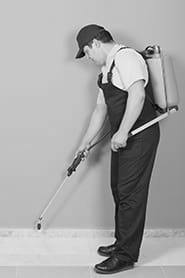Profession pest management worker

Vermin control workers investigate the presence of pests and vermin that are hazardous to public health or cause nuisance, lay traps and baits to eradicate pests, and treat areas of infestation.
Pest management worker Jobs: Open positions
Find the job of your dreams on Talent.com, one of the largest job sites worldwide.
Job postings: talent.comPersonality Type
Tasks pest management worker
- Inspect premises and study reports (e.g. from the public or property owners) to identify infestation source, pest entrances, extent of damage to property, access to infested locations, etc.
- Determine treatment required to eradicate pests and vermin.
- Measure area requiring treatment, calculate fumigant requirements, and estimate cost for service.
- Post warning signs and lock building doors to secure the area to be fumigated.
- Lay traps and baits, and fumigate and disinfect areas by spraying or dusting chemical solutions, powders or gases, to remove infestations.
- Return to sites to examine traps and the continued presence of pests.
- Dispose of dead and captured animals, and handle and store pesticides, following the correct procedures.
- Clean the work site after the completion of job, and proof the area to stop pests returning.
- Advise property owners on courses of action to prevent the return of pests.
- Liaise with environmental health officers, housing officers and other relevant authorities where measures on a large scale are required to remove pests.
- Record work activities performed and complete reports.
Related professions animal husbandry
- Animal carer (not in farms)
- Animal home manager
- Animal trainer
- Beekeeper
- Farrier
- Fur animals farm worker
- Fur animals farmer
- Horse breeder
- Horse riding centre manager
- Horse riding instructor
- Laboratory animals carer
- Pet animal breeder
- Stable groom
- Stable master
Knowledge
- Preventative measures against pests
Techniques and measures used to prevent unwanted bugs or animals in houses or buildings, such as installing wood protection and bird spikes.
- Chemical products
The offered chemical products, their functionalities, properties and legal and regulatory requirements.
- Safe use of pesticides
Precautions and regulations concerning the transport, storage and handling of chemical substances that exterminate pests.
- Pest biology
Biological characteristics of insect and rodent pest and their influence on choosing a pest management method.
- Pesticides
Types of chemical characteristics of pesticides and their adverse human and environmental effects.
- Personal protective equipment
Types of protective materials and equipment foreseen for various types of tasks such as general or specialised cleaning activities.
- National pesticide legislation
National legislation regulating the substances used and usage of pesticides.
- Herbicides
Types of chemical characteristics of herbicides and their adverse human and environmental effects.
- European pesticide legislation
The EU framework for community action which promotes the sustainable use of pesticides.
- Pest management techniques
Techniques and measures used to prevent unwanted pests in houses, buildings and their surroundings by preventing access or by deploying other techniques such as wood protection and bird management devices.
Skills
- Report on pest inspections
Provide written reports on all inspections carried out on buildings and all treatments applied and materials used to manage pests.
- Identify infestation source
Inspect buildings and surroundings to identify the source and extent of damage done to property by pests.
- Spray pesticides
Spray pesticide solutions to keep insects, fungus, weed growth, and diseases under control.
- Follow control of substances hazardous to health procedures
Adhere to the Control of Substances Hazardous to Health (COSHH) procedures for activities that involve hazardous substances, such as bacteria, allergens, waste oil, paint or brake fluids that result in illness or injury.
- Decide on infestation treatment type
Based on the evaluation of the infestation type and source, plan the treatment type to be applied such as fumigation, poison paste or bait, traps, spraying insecticides.
- Perform mathematical calculations in pest management
Make calculations to prepare the appropriate dose of pest control substance, in accordance to the surface affected and the type of rodent or insect in question.
- Communicate with customers
Respond to and communicate with customers in the most efficient and appropriate manner to enable them to access the desired products or services, or any other help they may require.
- Use personal protection equipment
Make use of protection equipment according to training, instruction and manuals. Inspect the equipment and use it consistently.
Optional knowledge and skills
maintain professional administration cleaning industry health and safety measures environmental engineering drive vehicles maintain customer service provide technical documentation maintain inventory of pesticides manage a small-to-medium business wood preservation phytosanitary measures protect plants during pest control advise on pest infestation preventionSource: Sisyphus ODB